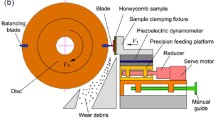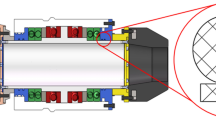Abstract
The rubbing wear behavior of the honeycomb land against labyrinth fin was investigated with finite-element-analysis method at a range of incursion conditions. The contact behaviors, material property, and material damage and failure are computed within the user-defined-subroutines. With the experimental data, the finite-element-analysis method was validated with respect to the frictional temperature and worn geometry. The effects of stator material, incursion depth, incursion rate and sliding velocity on the contact force, frictional temperature, material loss, and worn geometry are analyzed. The results show that the sliding velocity, final incursion depth and incursion rate are the important factors affecting the wear behaviors of honeycomb stator. The mushrooming extension is decreased with the increase of sliding velocity, and increased with the increase of incursion rate. At high sliding velocity and low incursion rate conditions, the material loss accounts more in the wear volume deformation compared to the plastic deformation.
Similar content being viewed by others
Abbreviations
- b :
-
Width of the honeycomb wall [mm]
- B :
-
Thickness of labyrinth fin tip [mm]
- c p :
-
Specific heat capacity [J/(kg·K)]
- D :
-
Diameter of the labyrinth fin tip [mm]
- E :
-
Elasticity modulus [GPa]
- F n :
-
Contact force [N]
- h :
-
Depth of honeycomb cell [mm]
- h air :
-
Heat transfer coefficient at air side [kW/(m2·K)]
- h c :
-
Contact heat transfer coefficient [kW/(m·K)]
- \(m_{{\rm{loss}}}^{\max }\) :
-
Total mass loss [mg]
- s :
-
Incursion depth [mm]
- \({\dot s}\) :
-
Incursion rate [mm/s]
- s final :
-
Final incursion depth [mm]
- t :
-
Time [s]
- T :
-
Temperature [K]
- T 1.4 :
-
Maximum temperature below cell tip by 1.4 mm [K]
- u f :
-
Failure displacement [mm]
- V f :
-
Sliding velocity of rotor [m/s]
- w :
-
Thickness of honeycomb wall [mm]
- \(W_{{\rm{loss}}}^{\max }\) :
-
Total mass loss percentage [-]
- \(W_{{\rm{loss}}}^{4.28}\) :
-
Mass loss percentage within 4.28 s [-]
- x :
-
Circumferential direction
- y :
-
Radial direction
- z :
-
Axial direction
- α :
-
Thermal expansion coefficient [K−1]
- δ :
-
Incline angle of labyrinth fin [°]
- ε :
-
Radiation emissivity [-]
- \({\overline \varepsilon ^{\rm{p}}}\) :
-
Equivalent plastic strain [-]
- λ :
-
Heat conductivity [W/(m·K)]
- μ :
-
Frictional coefficient [-]
- ν :
-
Poisson ratio
- ρ :
-
Density [kg/m3]
- τ f :
-
Frictional stress [Pa]
- -:
-
Time-averaged value
- CFD :
-
Computational fluid dynamics
- FEA :
-
Finite element analysis
References
R. E. Chupp, R. C. Hendricks, S. B. Lattime and B. M. Steinetz, Sealing in turbomachinery, Journal of Propulsion and Power, 22 (2) (2012) 313–349.
S. Wilson, Ensuring tight seals, Technical Report, v. 2, Sulzer Tech. Rev., 89 (2) (2007) 23–25.
J. Vance, F. Zeidan and B. Murphy, Machinery Vibration and Rotordynamics, John Wiley & Sons, New York, USA (2010).
T. Pychynski, C. Höfler and H. J. Bauer, Experimental study on the friction contact between a labyrinth seal fin and a honeycomb stator, ASME Turbo Expo 2015: Turbomachinery Technical Conference and Exposition (2015) GT2015-42430.
Y. Dogu, M. C. Sertçakan, A. S. Bahar, A. Pişkin, E. Arican and M. Kocagül, Computational fluid dynamics investigation of labyrinth seal leakage performance depending on mushroom-shaped tooth wear, ASME Journal of Engineering for Gas Turbines and Power, 138 (2016) 032503.
X. Yan, L. J. Lei, J. Li and Z. P. Feng, Effect of bending and mushrooming damages on heat transfer characteristic in labyrinth seals, ASME Journal of Engineering for Gas Turbines and Power, 136 (4) (2014) 041901.
Y. X. Chen, Z. G. Li, X. Yan and J. Li, Effects of mushroom-shaped tooth wear on the leakage performance and rotordy-namic coefficients of labyrinth seals, ASME Turbo Expo 2018: Turbomachinery Technical Conference and Exposition (2018) GT2018-75147.
J. Denecke, J. Färber, K. Dullenkopf and H. J. Bauer, Interdependence of discharge behavior, swirl development and total temperature increase in rotating labyrinth seals, ASME Turbo Expo 2008: Turbomachinery Technical Conference and Exposition (2008) GT2008-51429.
U. Rathmann, S. Olmes and A. Simeon, Sealing technology-rub test rig for abrasive/abradable systems, ASME Turbo Expo 2007: Turbomachinery Technical Conference and Exposition (2007) GT2007-27724.
C. Delebarre, V. Wagner, J. Y. Paris, G. Dessein, J. Denape and J. Gurt-Santanach, An experimental study of the high speed interaction between a labyrinth seal and an abradable coating in a turbo-engine application, Wear, 316 (1–2) (2014) 109–118.
D. Hasnedl and P. Epikaridis, Comparative study of a felt abradable seal, ASME Turbo Expo 2018: Turbomachinery Technical Conference and Exposition (2018) GT2018-75139.
L. Hühn, O. Munz, C. Schwitzke and H. J. Bauer, Experimental investigation on the rubbing process of labyrinth seals considering the material combination, ASME Turbo Expo 2020: Turbomachinery Technical Conference and Exposition (2020) GT2020-14918.
F. Ghasripoor, N. A. Turnquist, M. Kowalczyk and B. Couture, Wear prediction of strip seals through conductance, ASME Turbo Expo 2004: Turbomachinery Technical Conference and Exposition (2004) GT2004-53297.
N. Herrmann, K. Dullenkopf and H. J. Bauer, Flexible seal strip design for advanced labyrinth seals in turbines, ASME Turbo Expo 2013: Turbomachinery Technical Conference and Exposition (2013) GT2013-95424.
X. Yan and X. Dai, Experimental investigation on wear behavior of rectangular labyrinth fin against high speed rotor, ASME Journal of Engineering for Gas Turbines and Power, 143 (12) (2021) 121001.
X. Yan, X. Dai and K. He, Experimental study on rubbing wear characteristics of labyrinth seal with trapezoidal fins, ASME Journal of Tribology, 144 (3) (2021) 032301.
X. Yan, X. Dai and K. He, An experimental study on friction contact between chamfered labyrinth fin and high speed rotor, ASME Journal of Engineering for Gas Turbines and Power, 144 (6) (2022) 061007.
T. Pychynski, C. Höfler and H. J. Bauer, Experimental study on the friction contact between a labyrinth seal fin and a honeycomb stator, ASME Journal of Engineering for Gas Turbines and Power, 138 (6) (2015) 062501.
O. Munz, T. Pychynski, C. Schwitzke and H. J. Bauer, Continued experimental study on the friction contact between a labyrinth seal fin and a honeycomb stator: slanted position, Aerospace, 5 (3) (2018) 82.
O. Munz, L. Hühn, C. Schwitzke, H. J. Bauer, T. Fischer and S. Ulan kyzy, Experimental investigation on the rubbing process of labyrinth seals against honeycomb liners, ASME Turbo Expo 2020: Turbomachinery Technical Conference and Exposition (2020) GT2020-15935.
D. R. Sporer and L. T. Shiembob, Alloy selection for honeycomb gas path seal systems, ASME Turbo Expo 2004: Tur-bomachinery Technical Conference and Exposition (2004) GT2004-53115.
D. Soler, M. Saez de Buruaga and P. J. Arrazola, Experimental investigation of contact forces and temperatures in rubbing interactions of honeycomb interstate seals, IOP Conference Series: Materials Science and Engineering (2021) 012070.
X. Dai, X. Yan, K. He, J. Li and Z. P. Feng, Numerical investigations of leakage performance degradations in labyrinth and flexible seals due to wear, ASME Journal of Engineering for Gas Turbines and Power, 143 (5) (2021) 051003.
T. Fischer, S. Welzenbach, F. Meier, E. Werner, S. Ulan kyzy and O. Munz, Modeling the rubbing contact in honeycomb seals, Continuum Mechanics and Thermodynamics, 30 (2018) 381–395.
Dassault Systèmes, Abaqus Analysis User’s Guide, Section 37.1, Version 6.13. Providence, RI, Dassault Systèmes, USA (2013).
Dassault Systèmes, Abaqus User Subroutines Reference Guide, Section 1.2.17, Version 6.13. Providence, RI, Dassault Systèmes, USA (2013).
E. Orowan, The calculation of roll pressure in hot and cold flat rolling, Proceedings of the Institution of Mechanical Engineers, 150 (1943) 140–167.
M. C. Shaw, The role of friction in deformation processing, Wear, 6 (1963) 140–458.
M. C. Shaw, A. Ber and P. A. Mamin, Friction characteristics of sliding surfaces undergoing subsurface plastic flow, Journal of Basic Engineering (Trans. ASME, Ser. D), 82 (1960) 342–346.
L. Gardner, A. Insausti, K. T. Ng and M. Ashraf, Elevated temperature material properties of stainless steel alloys, Journal of Constructional Steel Research, 66 (5) (2010) 634–647.
G. R. Johnson and W. H. Cook, Fracture characteristics of three metals subjected to various strains, strain rates, temperatures and pressures, Engineering Fracture Mechanics, 21 (1) (1985) 31–48.
J. Frontán, Y. Zhang, M. Dao, J. Lu, F. Gálvez and A. Jérusalem, Ballistic performance of nanocrystalline and nanotwinned ultrafine crystal steel, Acta Materialia, 60 (3) (2012) 1353–1367.
D. M. Mulvihill, M. E. Kartal, D. Nowell and D. A. Hills, An elastic-plastic asperity interaction model for sliding friction, Tribology International, 44 (12) (2011) 1679–1694.
Acknowledgments
The authors are grateful for the supports by Natural Science Foundation of China (No.52076165 and No.51576151) and Natural Science Foundation of Shaanxi Province (Grant No. 2018JQ5027) for the present work.
Author information
Authors and Affiliations
Corresponding author
Additional information
Xin Yan is a Professor at Institute of Turbomachinery, Xi’an Jiaotong University. His main research interest has been in computational fluid dynamics with emphasis in turbomachinery aerodynamics and heat transfer. He is also involved in experimental work to understand the complex flow physics in turbo machines.
Haibo Wang is a master student at Institute of Turbomachinery, Xi’an Jiaotong University. His research interests mainly cover the sealing technology in turbo-machinery.
Rights and permissions
About this article
Cite this article
Yan, X., Wang, H. & He, K. Numerical investigations into the rubbing wear behavior of honeycomb seal. J Mech Sci Technol 37, 4375–4390 (2023). https://doi.org/10.1007/s12206-023-0752-7
Received:
Revised:
Accepted:
Published:
Issue Date:
DOI: https://doi.org/10.1007/s12206-023-0752-7




